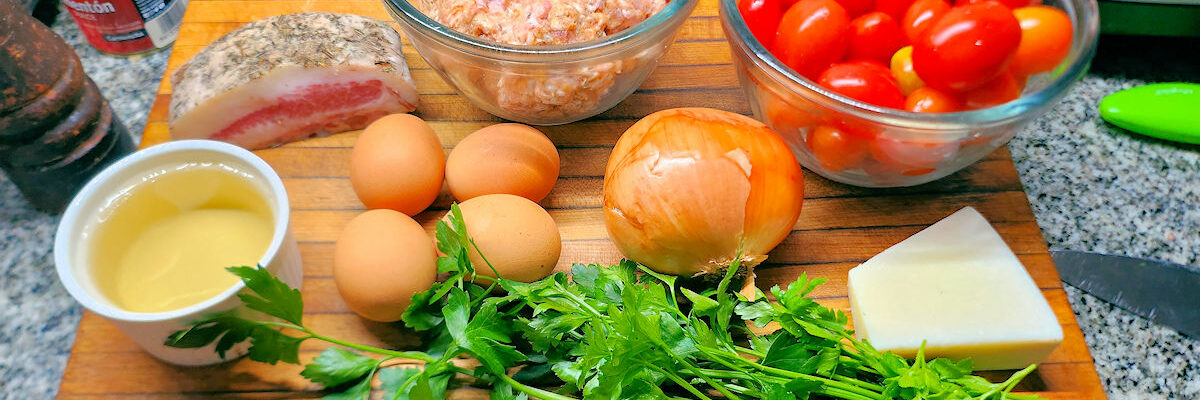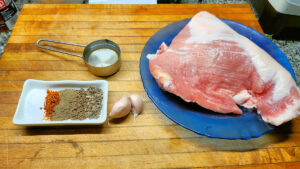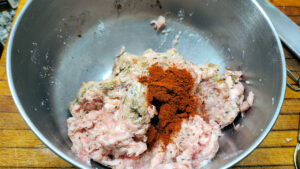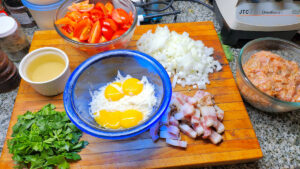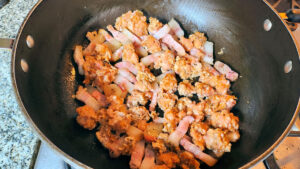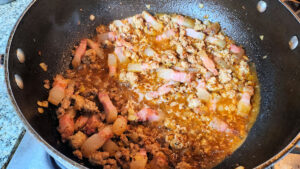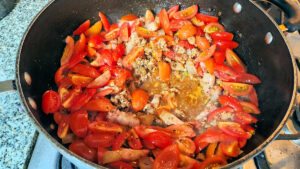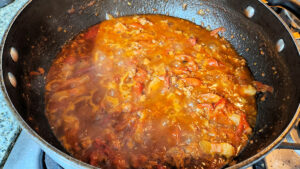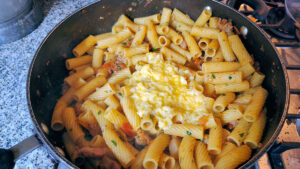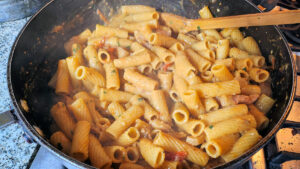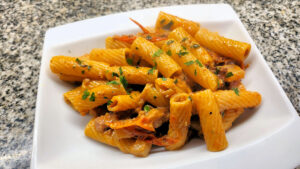I’m just going to throw out a (not so) wild guess that 99.9% of you have never encountered Pasta alla zozzona before. We’re still hanging out in Rome – I mentioned months ago that in response to someone’s assertion that there were really only four true Roman pastas that I could come up with dozens or more that he simply wasn’t aware of. Now, upfront, while I’ve heard and read about zozzona before, I’ve never actually had it in Rome, nor in any restaurant. Just once when an Italian-American friend cooked it for me. And, I gather, it’s not easy to find in restaurants there, unless you go off the beaten path… Trastevere is mentioned by more than one writer as the place to seek out little hole-in-the-wall kind of places that serve it up.
Now, some people tout this as simply a mashup of carbonara and amatriciana. And this is near to the mark, but an incomplete description, as zozzona also brings in onion and Italian fennel sausage to the mix. Let’s start with the name and a little history, perhaps? Though there’s an immediate association with zozzo, meaning dirty, or filthy, in Italian, the name actually appears to originate from the Roman dialect, where there is a type of cuisine, zozzeria, which is something rich and substantial. Kind of what most of us probably think of as comfort food. In dialect, zozzona refers to something that’s rich, hearty, a mix of things that defy description, but in the end, satisfying. A sort of “kitchen sink” dish that just plain works.
Let’s start with the Italian fennel sausage. Despite Argentina’s Italian-heavy roots, I’ve never found the stuff here. Neither the sweet nor hot. It makes no sense to me, but even in butcher shops and gourmet shops that specialize in Italian ingredients, fennel sausage, other than the cured salami-like finnocchiona, a Tuscan specialty, it just doesn’t seem to exist. Luckily, for this recipe, I don’t need encased sausages, just the filling. Here we have pork shoulder, garlic, salt, chili flakes (I’m making the hot, if this were the sweet, I’d just leave those out), black pepper, fennel seed, aniseed, and some cold water. Missing from the photo, a couple of teaspoons of smoked paprika (hot or sweet also acceptable, again, depending on how spicy or not you want this sausage).
I realized after grinding the meat and mixing it with everything there, that it wasn’t reddish in color, and that I’d forgotten the paprika, so added that in.
Then we’re all set for our pasta sauce. We’ve got our sausage meat off to the side, some chopped onions, guanciale, egg yolks and grated pecorino romano, parsley, white wine, and quartered or halved cherry tomatoes. This was a decision point – among the dozens of recipes I looked at, the type of tomatoes to be used was widely varied – from whole fresh, to peeled and canned, from plum to cherry, and even salsa or passata. There seemed a slight edge towards the use of smaller tomatoes, and the cherry tomatoes in the market looked nice and ripe, so I went that way. Some minor modifications as I was cooking – the whole bowl of sausage meat was more than I needed given the quantity I was making, and I only used about half of it, roughly double the quantity of the guanciale, and, I added in two more egg yolks to the four already there.
In retrospect, I don’t quite get this step the way most of the recipes are written. Pretty much everyone recommends browning the guanciale and sausage together. But the sausage meat browns so quickly that the guanciale doesn’t render out its fat and get nice and browned. Next time, and there will be a next time, I’m going to render it out completely, like making carbonara, set it aside, and cook the rest in the rendered fat, and only add the lardons of guanciale back in later on.
Somewhere in there the onions get added in, so that they soften and take on some color. Once you’re at the point where everything’s nice browned, deglaze the pan with the white wine and cook that down to absorb it.
Add in the cherry tomatoes and a good dose of freshly ground black pepper (this is the first point I added in any seasoning). This is probably where I’d add the guanciale back in, so it all cooks together. This is also the point where I dropped the rigatoni, the pasta of choice (or other similar tubular pastas, like penne rigate or tortiglioni), into boiling, lightly salted water.
As it cooks down, add a ladle or two of the starchy pasta water. Once the pasta is just short of being completely cooked, taste the sauce, adjust the seasoning – I didn’t find it needed any salt, just a bit more black pepper, and also add in the chopped parsley at this point.
Add the pasta in, toss it well, take it off the heat and add the creamed together yolks, grated cheese, and just enough pasta water to melt it together.
And, stir it vigorously to get it all nice and creamy and tasty. Give it a final taste, adjust as needed, and serve.
Here it is, pasta alla zozzona! All the richness and flavors of carbonara, amatriciana, and the added kick and flavors of chili, fennel, and anise from the sausage and onions. Note, again, as has come up in the past with these Roman pastas… no garlic other than a little in the sausage meat.
I may just stick with Roman pastas for a bit. Or not. We shall see. Henry wants me to showcase some South American pasta dishes, particularly Peruvian ones. Maybe we’ll go off on a tangent for a bit.
